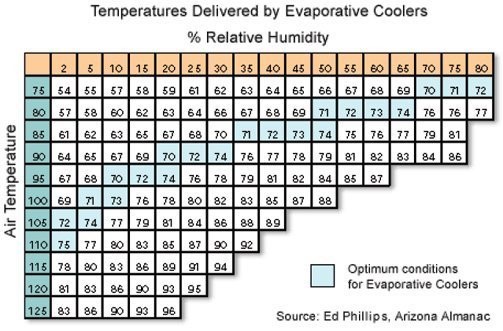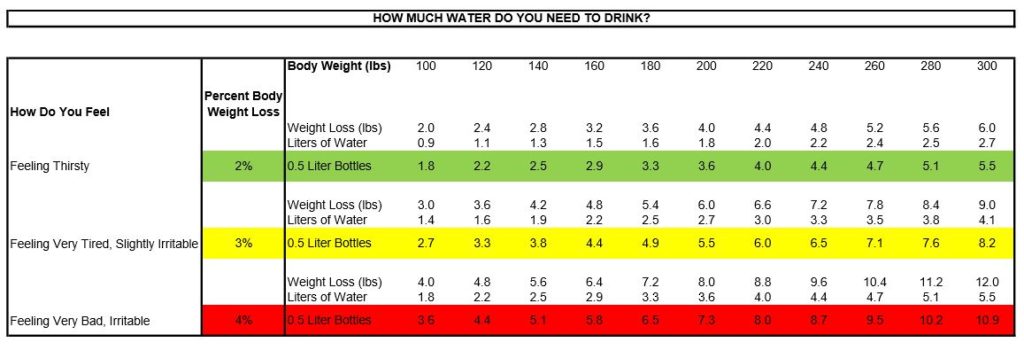How Much Water Do You Need
The Effects of Humidity, Temperature, and Evaporative Cooling on Dehydration
Written By Mike Meyer
October 21, 2019
Dehydration is a very common, possibly life-threatening, condition for people living in the American Southwest. It’s a very good idea to monitor and control your own hydration level, and the hydration levels of your friends or colleagues for safety reasons and simply to feel a lot better by avoiding dehydration. Generally speaking, dehydration will have the effect of making you feel tired and grumpy. You might also feel weak, dizzy, nauseous, develop a head ache, or have muscle cramps – at that point, it’s obvious. Typically, you won’t always notice this in yourself unless you make a conscious effort to look for it. You can usually spot dehydration with your friends if you pay attention to the changes in how they move and the changes in their disposition throughout the day.
The desert Southwest is hot, dry place filled with a diversity of plant, animal, and insect life. Living in, or visiting the Southwest will be a lot more enjoyable if you remain hydrated – you will definitely feel much better if you drink plenty of fluids.
Through my own repeated process of getting dehydrated while working outdoors in the relatively intense, dry summer heat of New Mexico I decided to take a more detailed look at the effects of humidity, temperature, and evaporative cooling on the human body and the need for hydration. Despite the fact that I was drinking plenty of water (so I thought), I was still feeling “overheated” and very tired in the afternoon. I originally thought it was just a function of the high temperatures causing me to overheat, however, cooling down didn’t really change the way I was feeling at the end of the day and I realized that I was not getting the hydration and electrolytes that I needed.
This initially seems very obvious. However, I was drinking a lot more water than during a typical day spent inside, but it still wasn’t enough. The question then arises of how much water should I be drinking?
Humidity and Temperature
My first impression was that the heat and dry air was just kicking my butt (somewhat true as we will see), so I looked at the effects of relative humidity and temperature on cooling to see what the correlation was between how I was feeling and these two important factors.
Evaporative cooling is popular in the Southwest because the dry air makes the process very efficient. The dryer the air, the better the evaporation, and the better the cooling. A review of the efficiency of evaporative cooling (swamp coolers) for air temperature versus relative humidity provides an idea of the significance these factors have on the inability to cool your body. The figure below basically shows where general evaporative cooling (also called sweating) works for you, (or doesn’t work for you) based on the air temperature and percent relative humidity.

The average afternoon humidity in Albuquerque, NM, in the summer is around 25% with temperatures around 95 degrees Fahrenheit. As you can see from the chart, evaporative cooling works very well to cool air down. That is, an efficient swamp cooler can drop 95° down to 76°. Swamp coolers work by pulling air through a water-saturated baffles. Evaporation increases dramatically with moving air. Therefore, if you have plenty of wind and your body is wet, you will cool down much better. Most of the time, you will not have the volume of water flowing over your body or the steady breeze you need to achieve these conditions and why you will feel overheated at times. You could be sweating a great deal and not know it because it is evaporating very quickly. Keep in mind that evaporative coolers have a constant supply of water and a fan to pull the heat from the air, so the numbers above don’t apply directly to your body, but it gives you an idea of how things work. The idea here is to use this technology and spray yourself down with water and stand in the breeze if you need to cool down.
Check the average humidity in the summer (or winter) for your area and see where you fall in the chart. Chances are, if you live in the eastern half of the U.S., evaporative cooling is not efficient and that’s why you are always covered in sweat in the summer. The evaporative effect doesn’t work very efficiently there and your body responds by sweating even more (trying to cool you down). The good thing about this is that you feel it and you see it, so you inherently drink more water. In the Southwest, you don’t see the sweat or feel it nearly as much because it is evaporating and hopefully cooling you down as it should. The down side is, you don’t always realize that you are sweating a lot and you don’t realize that you need to replace all that fluid. The three main external/environmental factors that affect how your body maintains its temperature are: temperature, humidity, and wind.
The key points are that, in the Southwest, you are sweating because it’s hot, but the low humidity is evaporating your sweat to cool you down, so you don’t realize that you are getting dehydrated. The solution is to drink water even when you don’t feel sweaty or thirsty.
How Much Water Do I Need to Drink?
It’s been stated that even a 1% to 2% of body water loss can impair your brain functions and the ability to think clearly, therefore it’s a good idea to remain hydrated. Depending on many factors, your body water content can range from approximately 45% to 75% of your total body weight.
Given this is a large range of values, let’s assume that we are 65% water for the purpose of this article. The following chart gives and idea of about how much water you should drink, based on your body weight. It is an approximation that should help you stay hydrated. I used half-liter bottles as a means to simplify your water intake because it is easy to monitor and most water bottles have a capacity of 0.5 to 1.0 liters. One liter is, for all practical purposes, very close to a quart.

From the chart you will see that if a 200-pound person looses 6 pounds of water in a day, they are down 2.7 liters of water and should drink about 6 – 0.5 bottles of water to balance things out. Our 200-pound person needs to be sure to add some electrolytes in the form of a sports drink to avoid a condition called hyponatremia. Hyponatremia is caused by flooding your system with too much water at one time and depleting your electrolytes in the process. This is also called water intoxication and can be fatal. Drinking too much water can cause fatigue, lethargy, disorientation, confusion, headache, nausea, vomiting, and if not treated properly, coma and death. These symptoms are similar to dehydration.
The only way to use this chart effectively is to weigh yourself daily to develop a baseline of your body weight before you have had anything to eat or drink. I recommend that you do this every morning, after you have “taken care of business” in the restroom. If you return home after a physically active 8-hour day (for example) in high heat and you lost 6 pounds…you’re dehydrated…and you will most likely feel pretty crappy. You should slowly rehydrate with water and sports drinks – too much, and too fast of either is not good for you. Based on this example, the best way for our 200-pound person to avoid this dehydrated situation is to drink about 0.5 liters of water every hour and a half throughout the day (8 hours divided by 2.7 liters give you about one 0.5-liter bottle per 1.5 hours). You can determine your hydration needs by checking your weight at the beginning and at the end of each day, making a mental note of what you ate and how much you drank.
The idea behind this article is to use 0.5-liter bottles as an easy standard to help you regulate how much water you should drink. Don’t forget to include electrolytes throughout the day. Remember that this is only a guide and you will have to adjust your hydration based on your body type, age, weight, gender, what you ate, and other factors. You will need to develop a baseline for your body weight and your fluid intake along the way.